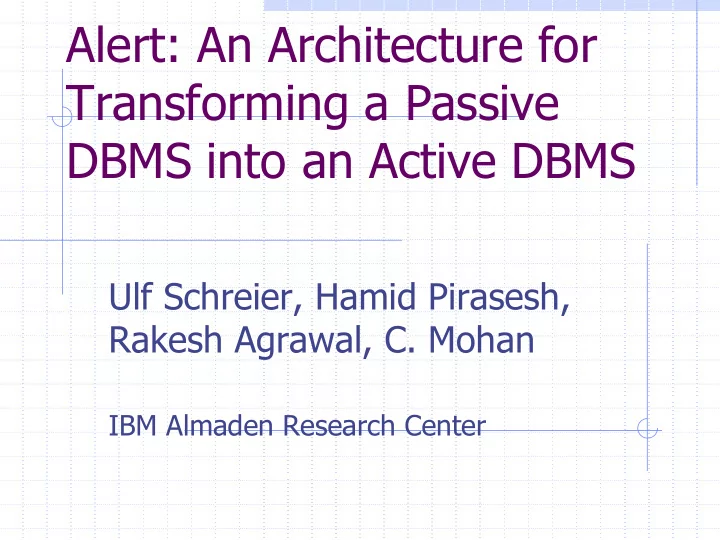

Alert: An Architecture for Transforming a Passive DBMS into an Active DBMS Ulf Schreier, Hamid Pirasesh, Rakesh Agrawal, C. Mohan IBM Almaden Research Center
Alert Idea Does not build an Active DMBS from scratch Extends a Passive DBMS into an Active DMBS Examples: � Active queries are written in SQL with minimal additions. � Indexing and Query optimization are used for event detection
Passive Tables / Cursors Cursor = bookmark for queries Query calls fetch which moves the cursor Loop until end of table No more results after table’s end
Active Cursors / Tables Active table = append only table Queries call fetch- wait Fetch-wait goes to sleep at end of table Awoken on update New results
Sample Active Query Declare C cursor for SELECT name, email FROM classlist Open C; while(TRUE) { fetch_wait C into:name,;email ;; send welcome to class email }
Alert Rules Rule = named active query Conditions in FROM and WHERE clause. Ex: Create rule temp_watch as SELECT alarm(‘EVACUATE!’) FROM temps WHERE location = ‘Nuclear Reactor’ AND temp > 500
Rule = SQL View Create rule exam as SELECT email(“registrar”) FROM rooms WHERE actual_capacity > max_capacity/2; Create rule fire-code-violation as SELECT phone(“Fire Department”) FROM exam WHERE actual_capacity > max_capacity;
Rule Activation Rules can be activated with consideration for three categories: � Transaction coupling = Same / Separate � Time coupling = Synchronous / Asynchronous � Assertion mode = Immediate / Deeferred
Transaction Coupling Same Coupling � Triggered transaction is part of triggering transaction � Ex: An integrity check should run as part of an insertion to correct it if necessary. Separate Coupling � Triggered transaction runs separately from its triggering transaction � Ex: A stock order should run separately from a query over stock prices.
Time Coupling Synchronous � Triggered transaction runs and triggering transaction waits for it to complete before running Asynchronous � Triggered transaction runs in parallel
Assertion Mode Immediate � The rule is triggered as soon as its condition is satisfied. Deferred � The rule is triggered only within certain parts of the triggering transactions. � Ex: A certain professor wants to allow students to work together during tests.
Restrictions Same must be synchronous Separate must be asynchronous Deferred can only be used in the same coupling mode. Why all these options? It seems like there are 8 combinations, but really only 3!
Monitor System -- Locks Ex: Rule that monitors bank accounts for accounts below the minimum balance � Most transactions will not result in a transaction applying to this rule. Regular locking scheme requires rule to wait for locks for useless data. Only waits for locks when a tuple meets rule conditions.
Monitor System – Adding tuples When a tuple is added we would like to quickly know to which rule it is applied. Modified B+ tree that alerts corresponding rules when a tuple is added to corresponding index Tuples have increasing Ids and therefore each tuple will be added to the end of buckets.
What to take away Active DBMS can be created by simply extending normal DBMS features. DSMS must be able to perform better than this extended type of DBMS.
Recommend
More recommend